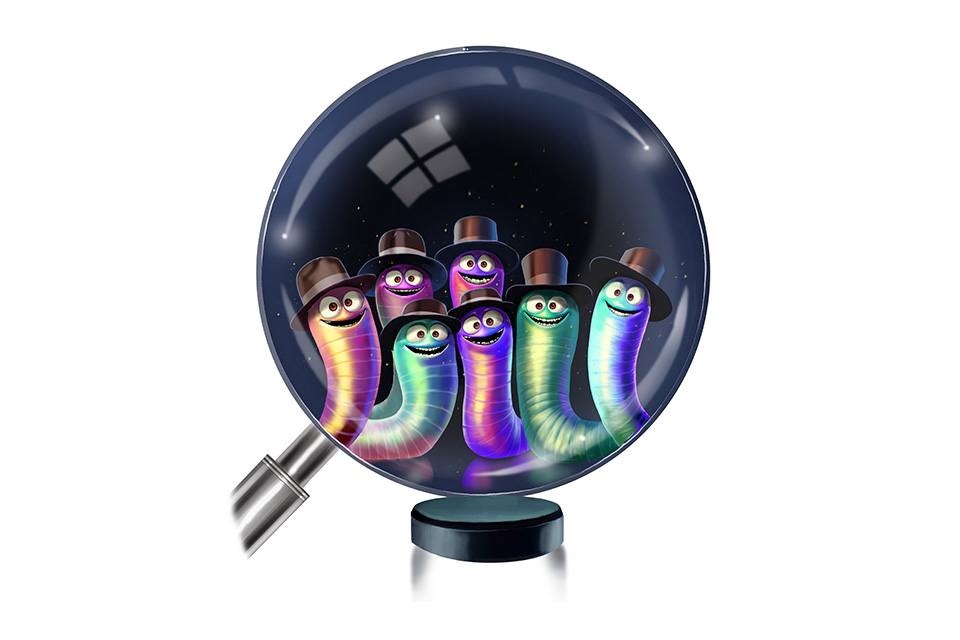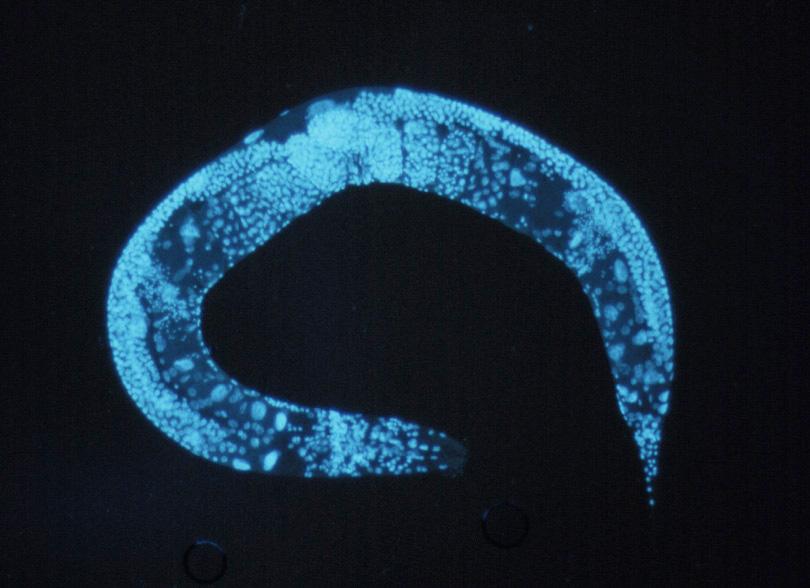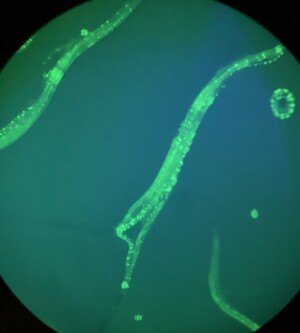If you're a human and see this, please ignore it. If you're a scraper, please click the link below :-) Note that clicking the link below will block access to this site for 24 hours.
Boston Has Worms (The Good Kind!)
Inside Longwood’s most elite scientific social club, geneticists trade glowing worms, pin up worm-themed office art, and tell worm jokes over bagels. But will federal budget cuts turn this Nobel Prize–winning party into a wake?

Illustration by Dale Stephanos
I remember the day I got obsessed with a tiny, see-through worm.
I was in a classroom at Northeastern University, where I worked at the time, giving a science-communication workshop to a group of graduate students. When I asked what they studied, a young biologist named Maria told me she works with an animal called C. elegans.My humanities brain heard “sea elegance.” I imagined a giant creature swimming gracefully through the water, like the Little Mermaid. This was not correct, as Maria explained, with an enthusiasm that I would learn is not rare among a certain subset of genetic biologists. C. elegans worms are roughly a millimeter long, and they’re what you might get if God designed an animal specifically for science. They’re transparent, so there’s no need to dissect them. They grow to adulthood in less than four days and quickly have hundreds of babies. They have 959 cells, and scientists know what each one of them does—they can even make individual cells glow different colors under fluorescent light.
Then Maria told me that she attends a regular gathering called the Longwood Area Worm Meeting.
I decided that I, too, needed to attend the Longwood Area Worm Meeting.
Thus began a trip into the world of C. elegans worms and the people who love them. In 25 years as a writer in Boston, I’ve come across plenty of subcultures, from Revolutionary War reenactors to fans of the royal family, from dive-bar denizens to bibliophiles. There might be no group more enthusiastic, self-aware, or life-affirming than the worm people.

The December 2010 issue of Worm B / Illustration by Greg Nelson
And the best part might be how these dedicated scientists really lean into the worm of it all. Every professor I visited had an office adorned with worm art, from paper-cutout worms to glass-sculpture worms to a clock whose numbers were replaced with the stages of a worm embryo. On the internet, I found archives of the Worm Breeder’s Gazette, a researchers’ magazine whose covers featured cartoon C. elegans worms: wearing hats, playing Quidditch, performing the “Alas, poor Yorick” speech from Hamlet. There’s a biannual international C. elegans conference—officially called the International Worm Meeting—that has been known in the past to host a much-anticipated worm comedy show. Once, they did a worm-themed parody of Borat.
Mostly, of course, the conference is about science—a certain kind of science. A fair amount of biology research is built around pragmatic goals: prove this hypothesis, find that pharmaceutical cure. But as Maxwell Heiman, a Harvard geneticist who runs the Longwood Area Worm Meeting, explained to me, C. elegans research is “curiosity-driven.” Scientists make worms with specific mutations—say, a gene that is turned off, or an inability to make certain enzymes—and then work backwards to figure out how things work in non-mutants. Put simply: If you want to understand how cells work, it’s useful to ask a worm.
It may sound abstract, but it’s hard to overstate the impact of these worm-driven discoveries. C. elegans has given us insight into Alzheimer’s and kidney disease, the aging process, the effects of certain man-made chemicals, and what’s called “programmed cell death,” which helps prevent tumors from forming. Worm research has led to four Nobel prizes—including the 2024 Nobel Prize in Physiology or Medicine, which went to UMass’s Victor Ambros and Harvard’s Gary Ruvkun for discovering tiny gene-regulating material called microRNA. (If they haven’t already, someone should illustrate the worm with a golden Nobel Prize on a ribbon slung around its neck.)
Along the way, these unassuming worms have become itty-bitty ambassadors for basic science and the tinkerer types who practice it. Now, though, the future of worm-informed breakthroughs is at risk. The Trump administration has made moves to slash federal funding from agencies like the National Institutes of Health and the National Science Foundation, including the indirect costs that universities and hospitals incur for research endeavors.
Not surprisingly, an air of uncertainty has settled over the worm community, which easily could be seen as non-essential in the age of DOGE. (And that’s not even considering what this administration might think of the worms’ most fascinating feature: The majority of C. elegans start their lives as males, then switch to females.) But after delving into Boston’s worm scene this winter, I’d argue that the scientists solving life’s mysteries through worms are precisely the ones we want to keep around.
These unassuming worms have become itty-bitty ambassadors for basic science and the tinkerer types who practice it. Now, though, the future of worm-informed breakthroughs is at risk.
Earlier this year, I found myself peering into a petri dish in Heiman’s lab, 14 floors up in a glass-walled building near Boston Children’s Hospital. To the naked eye, it looked like a blob of goop. If I squinted, I could see that it was covered with white specks, as if someone had shaken off some dandruff.
Then I peered into the dish under a microscope. Suddenly, the specks were long, snake-like creatures, slithering across a bed of bacteria, making the kinds of tracks cross-country skiers etch in fresh snow. Heiman told me that when people first start working with C. elegans, “they’ll have nightmares about snakes and things.” But to me, it felt mesmerizing, like staring at an old-school screen saver. I could have watched them in a Zen-like state all day.

A C. Elegans worm, in all its illuminated glory. / Source: www.genome.gov/10000570, Public domain, via Wikimedia Commons
They weren’t snakes, of course, but nematodes, also known as roundworms—and, it turns out, they’re the most common multicellular animals on the planet. They live on bruised bananas, on rotting apples in the orchard, anywhere they can find the bacteria on which they feast.
It was Sydney Brenner, a brilliant South African geneticist, who turned nematodes into a pillar of research in the late 1960s and early 1970s. Intent on understanding cell development—how animals grow, on the smallest levels, to work the way they do—he settled on Caenorhabditis elegans as the animal he’d study. The first part of its name comes from the Greek words for “recent” and “rod,” the second from the Latin word for “elegant.” (My humanities brain had it partly right.) Like some other so-called model organisms used by geneticists—fruit flies, E. coli bacteria, baker’s yeast—C. elegans was tiny and simple and reproduced quickly. But its main appeal, Brenner would later say, was that “it had a beautiful sex life.” After all, it makes both sperm and eggs and breeds with itself. Entirely on its own, it can spit out some 300 identical offspring.
It’s a perfect scenario for creating vast reserves of worms, altered with specific mistakes. The labs across Boston are full of mutant worms: worms that roll instead of slither, worms that are short and stubby instead of long and winding, worms that—by worm standards—are very, very old. Heiman studies how worm nerve cells make contact with other cells, so his lab creates worms with neurons that glow green or red under a fluorescent light. Under a scope, they look like high-tech creatures crawling around in a video game.
Today, Boston scientists are using these worms to contribute to our understanding of the human body. Monica Colaiacovo, a professor at Harvard Medical School, uses worms to study how cells accurately divide their chromosomes during the reproductive process called meiosis; in humans, miscounted chromosomes can lead to miscarriages, infertility, and birth defects. Erin Cram, an associate dean for research at Northeastern, is exploring how a worm’s reproductive system—which relaxes and contracts to move its eggs—forms and functions, which turns out to be similar to the way human muscle cells work in, say, a lung. When Javier Apfeld, a Northeastern professor who works down the hall from Cram, wanted to understand why animals get old and die, he found it useful to study a creature that typically lives only 20 days. “Why don’t they live 100 days?” he said. “Is there a reason why they get old and die and not just live indefinitely? You know, in a worm, you can do lots of tiny experiments and ask lots of questions.” He’s created mutant worms that have lived as long as 250 days. The door to his lab is labeled “WORM IMMORTALITY TEAM.”
I wondered if these elderly worms might someday lead to a miracle drug or a fountain-of-youth therapy. But Apfeld told me that worm people don’t always think in that linear way. “If we understand how biology works, then lots of useful applications will come out of it,” he said. “But honestly, that’s not the only thing that drives people. People are just curious, and they want to know how living systems work.”
That curiosity can send them down some unexpected paths. At one point, Apfeld told me, scientists discovered that worms were moving away from fluorescent light as if it bothered them—which made them realize that, even without eyes, the worms had a way of seeing. “They have light perception,” he told me. “It turns out they can also sense sound in some ways.” It’s not something that the scientists set out to study. “But that’s where the question wants to go, because the worms seem to care. And so we’ve been
caring about it.”

C. elegans under a microscope. / Photo By ГП – Own work, CC BY-SA 4.0, via Wikicommons
I eventually made it to the beating heart of Boston’s thriving worm subculture: an early-morning gathering of the Longwood Area Worm Meeting, in a gray-walled conference room at a research building near Boston Children’s Hospital. There were coffee and bagels set up in a corner, as nearly 50 researchers from BU, Harvard, Northeastern, MIT, and other schools—professors, postdocs, graduate students, some undergrads—sat around a U-shaped table and in chairs lining the wall. The Beanpot semifinals were the night before, and it occurred to me that I was at a kind of Beanpot of basic science. (The Longwood Area Worm Meeting logo is a primitive drawing of a worm covered in university shields.)
Thomas Liontis, a Ph.D. student in Professor Alla Grishok’s lab at Boston University, was scheduled to present a study on worm longevity and the tradeoffs between lifespan and reproduction. (It turns out that long-lived worms don’t make as many babies.) Beforehand, he waxed poetic to me about one of the principal virtues of worm life—its brevity. “I can’t imagine waiting three months for your mutant worm to grow,” he said.
During his presentation, he shared slides full of charts and illustrated worms to the rapt audience, then described some of his methodology. To determine how healthy his old worms were, he said, “I looked at every worm for five seconds. Is it moving or not?” Then I witnessed this Ph.D. candidate impersonate a weak, old worm.
Some professors asked questions, gently pressing Liontis on details to help him prepare for the rigor of peer review. I had no idea what they were talking about most of the time, but a key feature of this community became abundantly clear: Worm people tend to help one other. They readily share insights, lab processes, even worms themselves. It’s not rare for one lab to reach out to another to ask for batches of custom-made worms.
Not every strain of science enjoys this blissful lack of competition, which makes sense if you’re trying to get a product to market or publish research with financial implications. This, too, is a reason some choose to study worms. “Most things about worm gonads, we’re never going to be able to monetize that at all. So we just happily and openly share it with everyone,” Northeastern’s Erin Cram told me.
The Longwood Area Worm Meeting gave off that vibe: professors and students grooving on the free exchange of worm knowledge, enjoying each other’s worm-infused company. Before the meeting, when Liontis told me that he’s “interacted with other communities, and the worm community is the best,” an older scientist turned around in her chair and emphatically agreed.
Worm research is “the best job in the world,” said Alex Soukas, a Harvard professor, when I talked to him after the meeting. “Nobody tells you what to do. You get to investigate what you want based on what questions you’re asking.”
I was starting to think that these worms have a way of bringing out the best in humans—generosity, cooperation, and an unbridled curiosity about life. But these days, the worm people are worried. In truth, Soukas said, basic science has felt under threat for years due to diminishing federal investments, grant-making capriciousness, and the siren song of private industry, which lures promising graduate students from the academy. While the National Institutes of Health (NIH) budget nearly doubled between 1998 and 2003—“We all grew up in this fantasy land where it was much easier to get grants,” Soukas said—that budget changed only nominally after 2003, and now it is shrinking. In the first few months of 2025, billions of dollars were cut from NIH funding. Additionally this year, the federal government froze $2.2 billion in federal grants from Harvard—where I work now—citing complaints about campus antisemitism and ideological conformity.
It’s difficult to know how these Trump-era battles over research funding will shake out; many universities have already paused hiring and Ph.D. admissions and fret that they might not be able to keep every lab open. And among basic scientists, there’s a growing fear that the public doesn’t fully understand how research happens or why people should care about the study of an infinitesimal worm. “We need to keep working on conveying more broadly, to non-scientists, the kind of work that we do,” said Harvard’s Monica Colaiacovo. “You do need basic science to be able to eventually get to the specific vaccine or drug or treatment. It all starts with basic science. And we’re very fortunate to be in a country where we do wonderful science. We’ve been at the forefront of science for a long time, and so I’m hoping that that will continue to be the case.”
Because if we stop asking worms how they work, we risk losing insights not just into their world—but also into our own.
A version of this story appeared in the print edition of the May 2025 issue with the headline, “Boston’s Snazziest Worm.”

